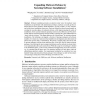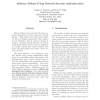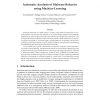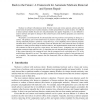16 search results - page 1 / 4 » Expanding Malware Defense by Securing Software Installations |
DIMVA
2008
13 years 6 months ago
2008
Software installation provides an attractive entry vector for malware: since installations are performed with administrator privileges, malware can easily get the enhanced level of...
IWIA
2005
IEEE
13 years 10 months ago
2005
IEEE
Malware defenses have primarily relied upon intrusion fingerprints to detect suspicious network behavior. While effective for discovering computers that are already compromised,...
SP
2006
IEEE
13 years 11 months ago
2006
IEEE
Attackers and defenders of computer systems both strive to gain complete control over the system. To maximize their control, both attackers and defenders have migrated to low-leve...
JCS
2011
12 years 7 months ago
2011
Malicious software—so called malware—poses a major threat to the security of computer systems. The amount and diversity of its variants render classic security defenses ineffe...
ACSAC
2006
IEEE
13 years 11 months ago
2006
IEEE
Malware is software with malicious intent. Besides viruses and worms, spyware, adware, and other newer forms of malware have recently emerged as widely-spread threats to system se...




